InterviewSolution
This section includes InterviewSolutions, each offering curated multiple-choice questions to sharpen your knowledge and support exam preparation. Choose a topic below to get started.
| 91401. |
(A) Anhydrous ZnCl_2 is used in reaction of alcohols with HCI.(R) ZnCl, forms a complex with oxygen of alcohol and converts - OH into a much better leaving group. |
|
Answer» Both (A) and (R) are true and (R) is the CORRECT explanation of (A) |
|
| 91402. |
(A) Anhydrous nitric acid can be obtained by distillation of conc. HNO_(3)with P_(4)O_(10). (R ) HNO_(3) is a strong acid. |
|
Answer» Both (A) and (R ) are true and (R ) is the CORRECT EXPLANATION of (A) |
|
| 91404. |
(A) and (B) respectively |
|
Answer»
|
|
| 91405. |
A and B in the following reactions are : |
|
Answer»

|
|
| 91407. |
A and B in the following reactions are respectively (i) CHCl_(3) overset( "Zn + H"_(2)O )(rarr) A (ii)CHCl_(3) overset(Zn + HCl )(rarr) B |
|
Answer» `CH_(2)Cl_(2) and CH_(4)` |
|
| 91408. |
A and B liquids on mixing produced a warm solution. Which type of deviation is there and why ? |
| Answer» Solution : Negative deviation. Warm solution means EXOTHERMIC or GREATER force of attraction between A and B than between A - A or B – B. | |
| 91410. |
a' and 'b' are van der Waals' constant for gases. Chlorine is more easily liquefied than ethane because |
|
Answer» a for `Cl_(2) LT a ` for `C_(2) H_(6)` but b for `Cl_(2) gt b` for `C_(2) H_(6)` |
|
| 91411. |
A and B can be: |
|
Answer» homomers 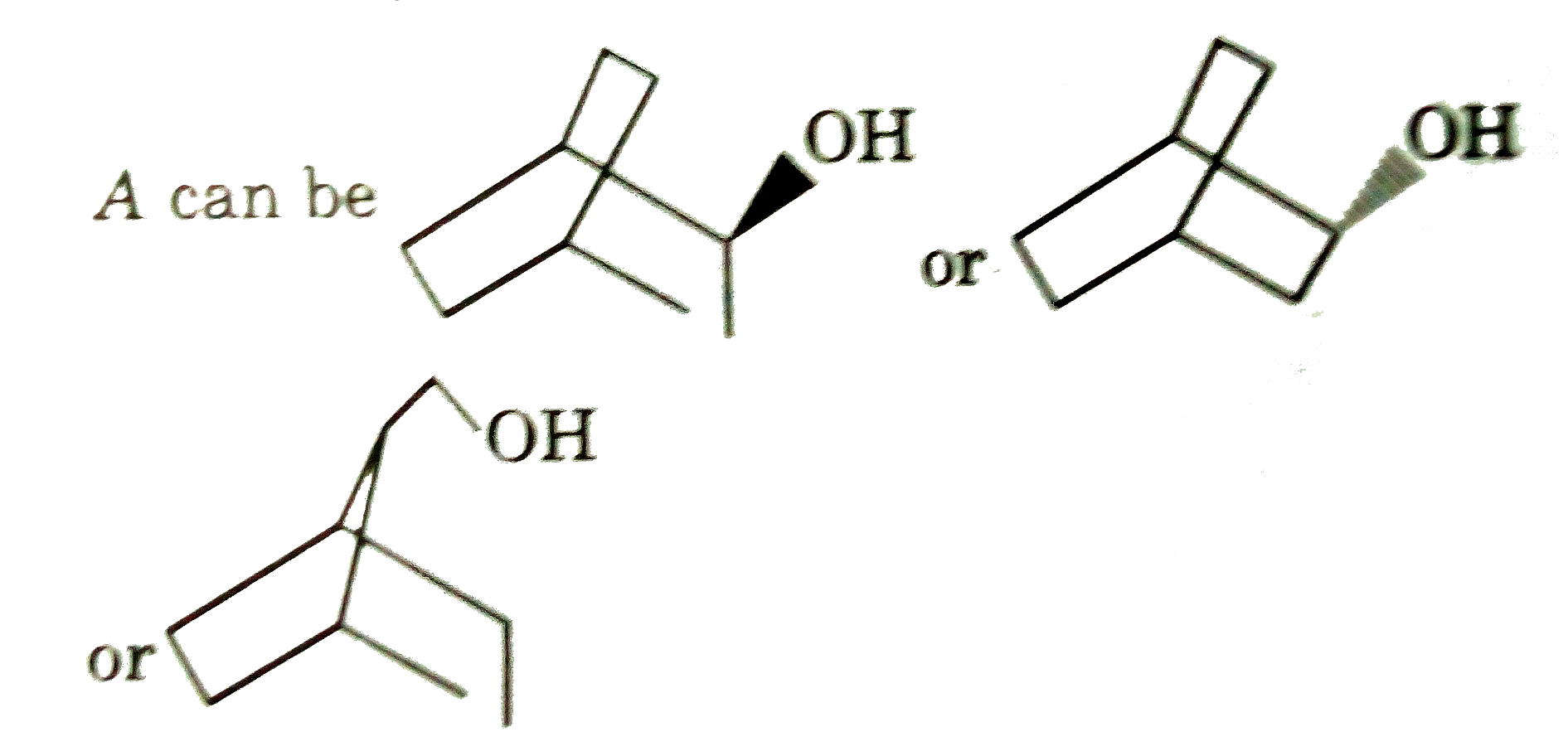
|
|
| 91412. |
A and B are two solutions, each of which has a volume of1L. The solution A contains 1 mol of NH_4CI and 1 mol < NaOH, while the solution B contains 1 mol of NH_ 4Cl and 1 mol of NH_3 . If pH values of the solutions A and are (pH) A and (pH) 8 respectively and pK b for NH_3 4.74, then the ratio of (pH)_A and (pH)_B is- |
|
Answer» 1.85 |
|
| 91413. |
A and B are two salts. A with dilute HCl and A and B with conc. H_2SO_4 react to give reddish brown vapours, hence A and B respectively are: |
|
Answer» `NABR, NaNO_3` |
|
| 91414. |
A' and 'B' are two isomeric compounds of the formula C_(2)H_(5)NO. 'A' on treatment with P,Os gives 'C'. Both 'A' and 'C' on alkaline hydrolysis evolve NH_(3). 'B' can be easily prepared from acetaldehyde. ‘A' is amphoteric inature and acid derivative. 'C' is |
|
Answer» `CH_(3)C-=N` |
|
| 91415. |
A and Bare two radioctivesubstancewith half lives 20 min and d30 min respectively. Startingfrom equal numberof moles A and B , after1hr , whatis the (a) ratio ofmoles of A and B and (b) ratio of activityof A and B ? |
|
Answer» Solution :The GIVEN TIME, 1 hour is 3 `t_(1//2)` for substance A and 2 `t_(1//2)` for substance B The fraction of A left after 3 `t_(1//2)=1//2^(3)=1//8` The fraction of B left after 2 `t_(1//2)=1//2^(2)=1//4` (a) The ratio of moles left `-1//8,1//4-1:2`. (b) The ratio of activities `=(lamda_(A)N_(A))/(lamda_(B)N_(B))=(N_(A)(t_(1//2))_(B))/(N_(B)(t_(1//2))_(A))=((1//8)xx30)/((1//4)xx20)=3:4` |
|
| 91416. |
A' and 'B' are two isomeric compounds of the formula C_(2)H_(5)NO. 'A' on treatment with P,Os gives 'C'. Both 'A' and 'C' on alkaline hydrolysis evolve NH_(3). 'B' can be easily prepared from acetaldehyde. ‘A' is amphoteric inature and acid derivative. The structure of ‘A' is |
|
Answer» `CH_(3)-overset(O)overset(||)C-NH_(2)` |
|
| 91417. |
A and B are two funtional isomers of compound C_(3)H_(6)O. On heating with NaOH and I_(2), isomer B forms yellow precipitate of iodoform whereas isomer A does not form any precipitate. Write the structures of A and B. |
|
Answer» Solution :Two possible functional isomes having the M.F. `C_(3)H_(6)O` are: `underset("Propanal (A)")(CH_(3)CH_(2)CHO)""underset("Acetone (B)")(CH_(3)COCH_(3))` Since isomer B on HEATING with NaOH and `I_(2)` forms YELLOW ppt. of `CHI_(3)`, therefore, it MUST be a methyl ketone, i.e., isomer B is acetone `underset("Acetone (B)")(CH_(3)COCH_(3)) underset(("Iodoform reaction")) overset(I_(2)//NaOH,Delta)to underset("Sod. acetate")(CH_(3)COONa)+ underset("Iodoform (yellow ppt.)")(CHI_(3))` In other words, isomer A which does not give any ppt. with `NaOH//I_(2)` must be propanal `underset("Propanal (A)")(CH_(3)CH_(2)CHO) underset(Delta)overset(I_(2)//NaOH)to ` No ppt. of `CHI_(3)`. |
|
| 91418. |
A and B are two hydrocarbons. A and B are heated separated in excess of oxygen when 0.028 g of A gave 44.8mL CO_(2) and 0.44g of B gave 67.2mL CO_(2) at NTP. Show that the results are in agreement with law of multiple proportions. |
|
Answer» Solution :Determine the masses of `CO_(2)` at NTP and then masses of carbon. (A) Mass of `CO_(2)=(44)/(22400)xx44.8=0.088g`. (B) Mass of `CO_(2)=(44)/(22400)xx67.2=0.132g` mass of carbon=0.036g, mass of hydrogen =0.008 g Thus, the masses of carbon combining with same mass of hydrogen are in the ratio of 4:3 which is a SIMPLE ratio. Hence, law of multiple proportions is followed. |
|
| 91419. |
A' and 'B' are two isomeric compounds of the formula C_(2)H_(5)NO. 'A' on treatment with P,Os gives 'C'. Both 'A' and 'C' on alkaline hydrolysis evolve NH_(3). 'B' can be easily prepared from acetaldehyde. ‘A' is amphoteric inature and acid derivative. 'B' is |
|
Answer» `CH_(3)-CH=NOH` |
|
| 91420. |
A and B are two identical vessels. A contains 15 g of ethene at 298 K and 1 atm. The vessel B contains 75 g gas X_2 at the same temperature and pressure. The vapour density of X_2 is : |
|
Answer» 75 |
|
| 91421. |
A and B are the compounds with the molecular formula C_3H_9N.These are oxidised by KMnO_4 and subjected to hydrolysis. If A gives propanal and B gives propanone , A and B are respectively. |
|
Answer» 1 -PROPANAMINE ,2- propanamine |
|
| 91422. |
A and B are two allotropes of an element . One gram of B in : |
|
Answer» OXIDATION NUMBER |
|
| 91423. |
A and B are respectively : |
|
Answer»
|
|
| 91424. |
A and B are two allotropes of an elemt . One gram of B in : |
|
Answer» OXIDATION NUMBER |
|
| 91425. |
A and B are elements with atomic numbers 16 and 17. Write different combinations of binary compounds known from them. |
| Answer» Solution :Atomic number of `A = 16`. It is sulphur. Atomic number of `B = 17`. It is chlorine. Excess sulphur reacts with chlorine to give DIMERIC MONOCHLORIDE. Sulphur reacts with excess chlorine to give tetrachloride. Molten dimeric monochloride on saturation with chlorine GIVES dichloride. `2S+Cl_(2)rarr S_(2)Cl_(2),S+2Cl_(2)rarrSCl_(4) andS_(2)Cl_(2)+Cl_(2)rarr 2SCl_(2)` | |
| 91426. |
'A' and 'B' are |
|
Answer»

|
|
| 91427. |
A and B are |
|
Answer»

|
|
| 91428. |
A and B are |
|
Answer»
|
|
| 91429. |
A and B are |
|
Answer» `CH_(3)CH_(2)O OH,CH_(3)CH_(2)OH` |
|
| 91430. |
A and B are ? |
|
Answer» CHAIN Isomers |
|
| 91431. |
(A) and (B) are: |
|
Answer» a. 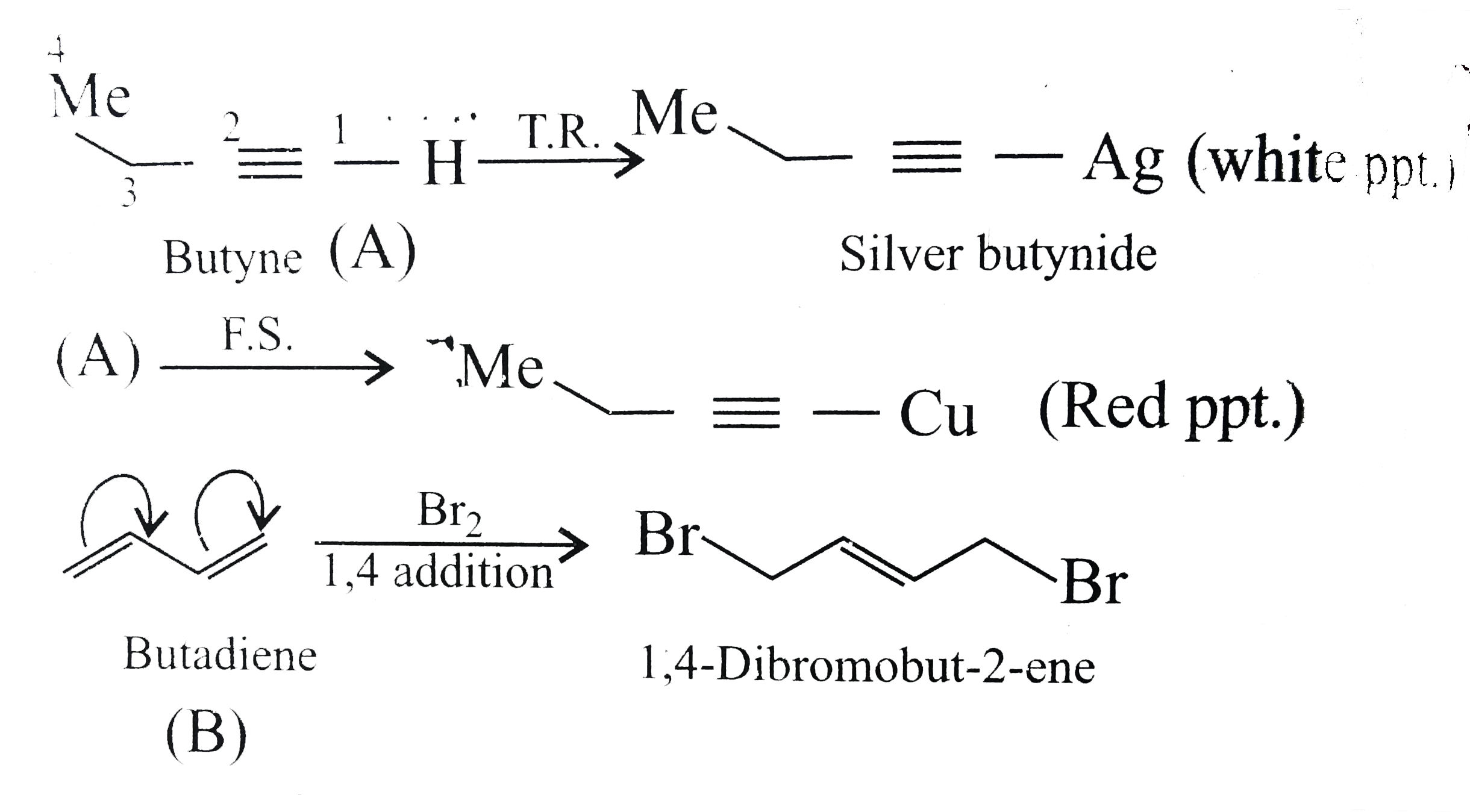 so the ANSWER is (a). |
|
| 91432. |
A analysis of a pyrex glass showed 12.9% B_(2)O_(3), 2.2% Al_(2)O_(3),3.8%Na_(2)O,0.4%K_(2)O and remaining is SiO_(2). What is the ratio of Si to B atoms in the glass ? (At. Masses : Si = 28, B = 11, Al = 27, Na = 23, K = 39) |
|
Answer» Solution :`SiO_(2)" present in 100 g of glass"=100-(12.9+2.2+3.8+0.4)=80.7g` `=(80.7)/(28+2xx16)"mole"="1.345 MOLES of "SiO_(2)` `"= 1.345 mole of Si atoms"` `=1.345xx6.023xx10^(23)" atoms"` `B_(2)O_(3)" present in 100 g glass "=12.9 g=(12.9)/(2xx11+3xx16)"mole"="0.184 mole of "B_(2)O_(3)` `=2xx0.184" mole of B atoms"` `=0.368xx6.02xx10^(23)" atoms"` `therefore"Si atoms : B atoms = 1.345 : 0.368 = 3.65 : 1 = 11 : 3"` |
|
| 91433. |
(a) An organic compound with the molecular formula C_9 H_(10)O forms 2, 4-DNP derivative, reduces Tollen's reagent and undergoes Cannizzaro reaction. On vigorous oxidation, it gives 1,2-benzenedicarboxylic acid. Identify the compound. (B ) Arrange the following compounds in the increasing order of their reactivity in nucleophilic addition reaction : Ethanal, propanal, propanone, butanone. (c) Although p-hydroxybenzoic acid is less acidic than benzoic acid, ortho hydroxybenzoic acid is about 15 times more acidic than benzoic acid. Explain. |
Answer» SOLUTION :Thegivencompoundforms2,4-DNPderivationtherefore, it ISAN aldehydeor ketone. Sinceit reduceTollen.sreagentit mustbe analdehyde . The compoundundergoescannizzaro.sreactionsoitdoes notcontaina- hydrogen.onvigorousoxidation, itisgives1,2- benzenedicarboxylicacid,ti meansthatit must becontainingalkylgroupat -2- positionwithrespectto CHOgroupon thebenzenring  (b) Butanone< propanone< propanal < ehtanal (c )-OHgroupis electron relasinggroupand thereforeitincreases the negativechargeon theanion.As ARESULT , p- hydroxybenzoicacid islessacidicthanbenzoicacidhowever. o - hydrogxybenzoicacid ismore acidicthenbenzoicacidethancesacidityof o-isomeris duetoveryeffectiveintramolecularhydrogenbondingin thecarbonylateion. As a result , o- hydroxybenzoateionstabilizedto a greatextentand THEREFORE, it makeso- isomermoreacidic 
|
|
| 91434. |
(a) An organiccompound(A)of molecular formula C_(6)H_(6)O giveswhitepreclpitate withbrominewater. (A) onreactionwith NaOH gives(B). (B) reactswith methyl lodlde inpresenceof dryethergives(C) ofmolecularformulaC_(7)H_(8)O which willnot liberateH_(2) gaswithmetallicNa (C)reactionwith acetylchloride gives(D)and (E)of formulawhich arepositionisomers. Identify A,B,C,D &Eand explainthe reaction (b )(i) Whathappenswhen n-propylbenzene is oxidised usingH^(+)//KMnO_(4) (ii) Identify A,B, andC |
|
Answer» Solution :a 1. An organiccompoundgiveswhiteprecipitatewith bromicwatermeansit MUSTBE aphenolfromthe molecularformulait isidentified as `C_(6)H_(5)OH` 2. Phenol ONREACTIONWITH NaOH gives (b) assodiumphenoxide `C_(6)H_(5) ONa`  3. Sodiumphenxide on reactionwithmethyliodidein the pressureof dryetherundergoWilliamsonssynthesisand givesAnisoleas (C ) 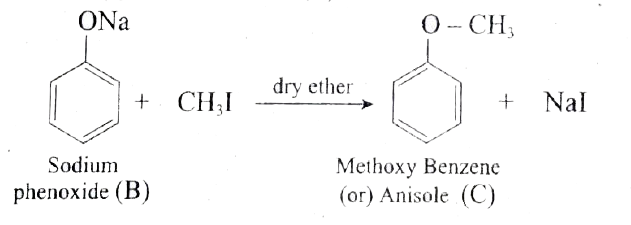 4. Anisoleonreactionwithacetlychlorideundergoes Friedel Craftacetylationyield o-methoxyacetophenoneand p- methoxyacetphenone as (d ) and (E )  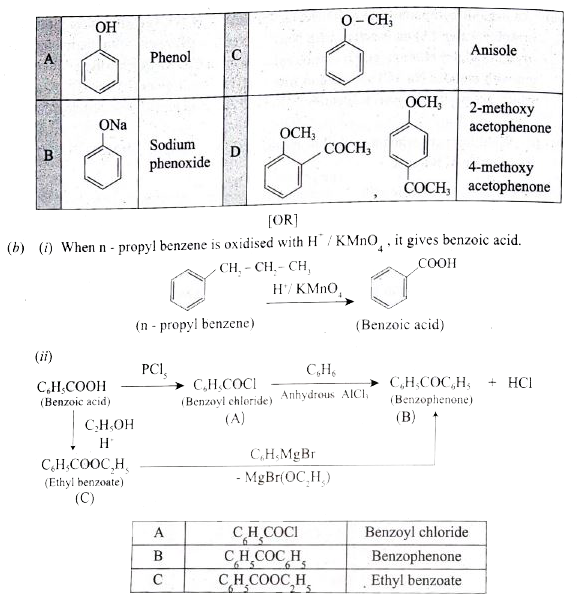
|
|
| 91435. |
A: An organic compound on diazotisation followed by reaction with alkaline solution of beta- naphthol gives orange dye. R: An organic compound is aromatic amino compound which forms diazonium salts and undergoes coupling reaction to from azo dye. |
|
Answer» Both A and R are true and R is correct explanation of A 
|
|
| 91436. |
(a) An organic compound (A) having molecular formula C_(4) H_(8) O gives orange red precipitate with 2, 4-DNP reagent. It does not reduce Tollens' reagent but gives yellow precipitate of iodoform on heating with NaOH and I_2. Compound (A) on reduction with NaBH_4 gives compound (B) which undergoes dehydration reaction on heating with cone. H_(2) SO_(4)to form compound (C). Compound (C) on ozonolysis gives two molecules of ethanal. Identify (A), (B) and (C) and write their structures. Write the reactions of compound (A) with (i) NaOH//I_2 and (ii) NaBH_4. (b) Give reasons : (i) Oxidation of propanal is easier than propanone. (ii) alpha-hydrogen of aldehydes and ketones is acidic in nature. Or (a) Draw structures of the following derivatives : (i) Cyanohydrin of cyclobutanone (ii) Hemiacetal of ethanal (b) Write the major product(s) in the following : (i) CH_(3) - CH=CH- CH_(2) - CN underset((ii) H_(3) O^(+)) overset((i)"DIBAL"-H)(to) (ii) CH_(3) - CH_(2) - OH overset(CrO_(2)) (to) (c) How can you distinguish between propanal and propanone ? |
|
Answer» Solution :(A) `= underset("Butan-2-one")(CH_(3) COCH_(2) CH_(3))` (B) `=CH_(3) - overset(overset(OH)|)(C)underset("Butan-2-ol")(H-CH_(2)) -CH_(3)` ( C) `=CH_(3) - underset("But-2-ene")(CH=CH)- CH_(3)` (D) `=underset("Ethanal")(CH_(3) CHO)` Ketones react with 2, 4-DNP REAGENT to form orange red precipitate. Ketones do not reduce Tollen.s rc,]gent. Methyl ketones (containing `CH_(3) CO-`group) give iodoform test. Hence the above structure of (A).`CH_(3) - overset(overset(O)||)C-CH_(2) - CH_(3) underset("NaOI")overset(NaOH//l_(2) )(to) underset("Iodoform")(CHI_(3)) +underset("Sodium propionate")(CH_(3) CH_(2) COONa)` `CH_(3) -overset(overset(O)||)C-CH_(2) underset(2[H]) overset(NaBH_(4) ) to CH_(3) -overset(overset(O)||) (C) underset("Butan-2-ol")(H- CH_(2) )- CH_(3)` (b) (i) Oxidation of propanal is easier than propanone Propanol is easily oxidised to PROPANOIC acid on treatment with common oxidising agents like nitric acid, POTASSIUM permanganate or potassium dichromate. Oxidation of propanone involves breaking of carbon-carbon bond and therefore requires drastic conditions. (ii) `alpha-` hydrogen of ALDEHYDES and ketones is acidic in nature  The species obtained after the removal of H+ is stabilised by resonance. OR (a) (i) Cyanohydrin of cyclobutanone  (ii) HEMIACETAL of ethanal  (b) (i) `CH_(3) - underset("Pent-3-enal") (CH = CH )- CH_(2) - CHO` (ii) `underset("Ethanal")(CH_(3) CHO)` (c) Distinguish between propanal and propanone. Tollens. Reagent Test: Propanal on treatment with ammoniacal silver nitrate gives a bright silver mirror. This test is not given by propanone. Fehling.s Solution Test: Propanal on heating with Fehling solution gives a reddish brown precipitate. Propanone does not give this test. |
|
| 91437. |
(a) An ideal gas undergoes a single stage expansion against a constant opposing pressure from (P_(1),V_(1),T)" to "(P_(2),V_(2),T). What is the largest mass m which mass m which can be lifted through a height h in this expansion? (b) The system in (a) restored to initial state by a single compression. What is the smallest mass ‘m’ which must fall through the height h to restore the system? (c) What is the net mass lowered through height h in the cycle transformation in (a) and (b) ? |
| Answer» Solution :`"(a) "m=(nRT)/(GH)(1-P_(2)/P_(1)),"(B) "m'=(nRT)/(gh)(P_(1)/P_(2)-1),"(C) "m'-m=(nRT)/(gh)((P_(1)-P_(2))^(2)/(P_(1)P_(2)))^(2)` | |
| 91438. |
(A) An alkane ,C_(6) H_(14) givestwo monochoro derivative giveits strutuire ( B)C_(6) H_(12)(A) has chrial centre, when it is hydrogentedgivesC_(6) H_(14) (B) in whichthereis nochrialcentreidentify (A) and (B) (C ) C_(5) H_(11) Clgives2,2,5,5-tetramethylexane as maoin productsonWurtzreactionGivethe struture of C_(5)H_(11)Cl' |
Answer» SOLUTION :
|
|
| 91439. |
(A) An emulsionbecomes stable if saop is added to it. (R ) Saop contains hydrophilic and hydrophobic parts. |
|
Answer» Both (A) and (R ) are true and (R ) is the CORRECT explanation of (A) |
|
| 91440. |
a. An armatic compound (A) (C_(7)H_(8) O) on reaction with Br_(2) + H_(2)O gives a white ppt. of compound (B) (C_(7) H_(5) Obr_(3)). Compound (C), an isomer of (A) also gives the same reaction and gives a white ppt. of compound(D) (C_(7) H_(5) OBr_(3)). Compound (C)is insoluble in NaOH. identify (A), (B), (C) and (D). b. I. Starting from C_(6) H_(6) and C_(6) H_(5) OH, synthesise phenyl 1-2,4- dinitrophenyl ether (B). II. Could we have first prepared and then nitrated Ph_(2)O ? c. 4- Chlorobutanol overset(ᶱ)overset(OH)(rarr) (A) rarr (B) + Cl d. HOCH_(2)- CH_(2) - CH_(2)OH underset(160-170^(@)C)overset("Conc". H_(2) SO_(4))(rarr) |
Answer» SOLUTION :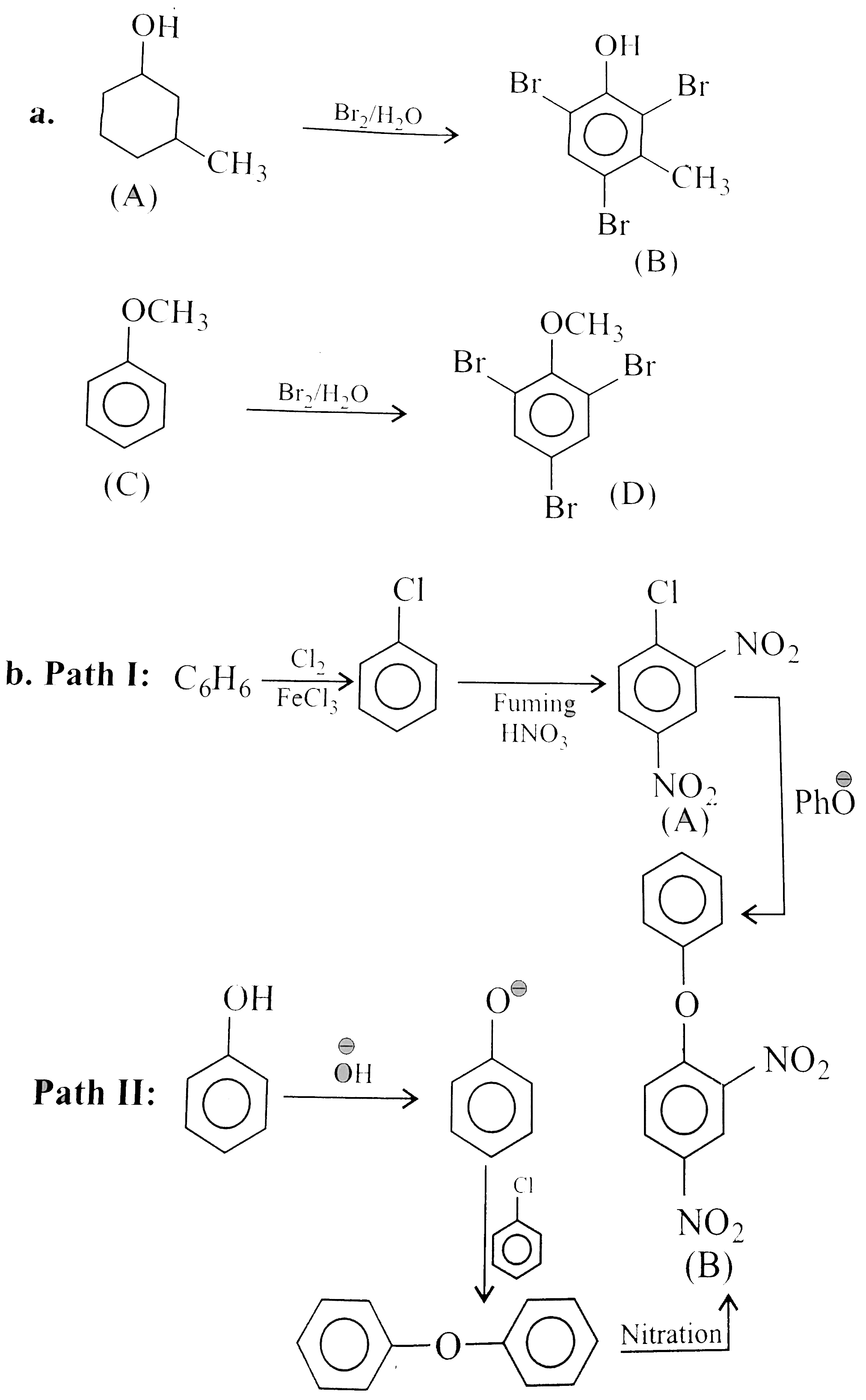 The `Cl` UNDERGOES aromic mucleophilic displacement because it is activated by two `(-NO_(2))` groups. II. The ring with first nitro group is deactivated so that the SECOND nitro group enters the other ring. The product is  c. This is an example of intramolecular Williamson's reaction. 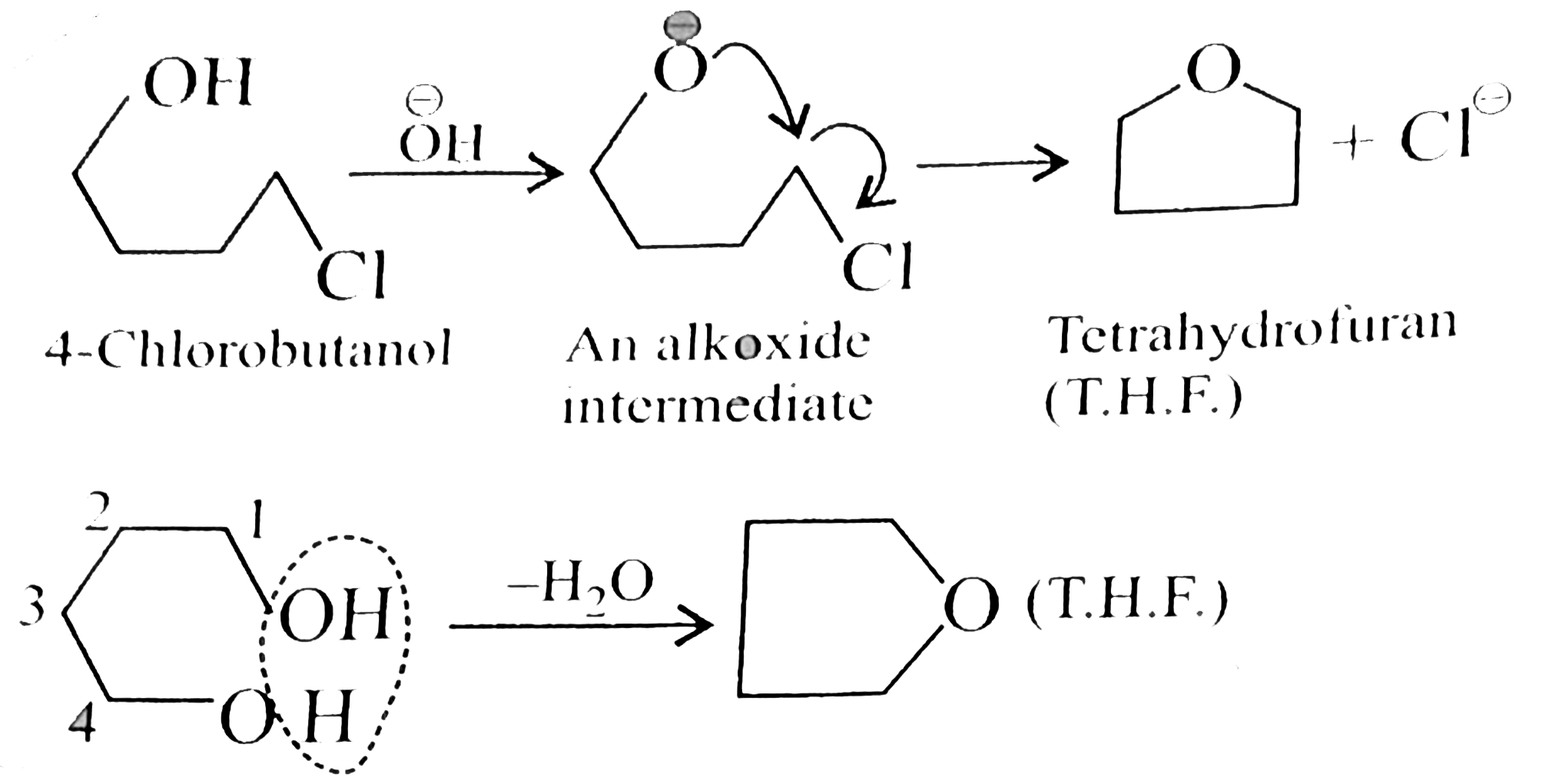
|
|
| 91441. |
(A) Amorphous Substances are isotropic (R) Properties like refractive index, electrical conductance have different value in diffe-rent direction for isotropic substances. |
|
Answer» Both (A) and (R) are true and (R) is the CORRECT EXPLANATION of (A) |
|
| 91442. |
(A) Among trihalides of nitrogen NF_(3) is most stable (R ) NF_(3) is a ionic compound. |
|
Answer» Both (A) and (R ) are true and (R ) is the correct EXPLANATION of (A) |
|
| 91443. |
(A) : Among the carbonyl compounds , formaldehyde is the most reactive towards addition. (R) :Smaller the alkyl group bonded to carbonyl group , more is the reactivity . |
|
Answer» Both A & R are true, R is the correct EXPLANATION of A |
|
| 91444. |
(A) Among the carbonyl compounds, formaldehyde is the most reactive towards addition. (R) Electrophilicity of carbonyl carbon in formaldehyde is maximum. |
|
Answer» Both (A) and (R) are TRUE and (R) is the correct explanation of (A) |
|
| 91445. |
(A) Among oxyacids of phosphorus, hypophosphorous acid is the best reductant (R ) More the number of P-H bonds in the oxyacid, more is the reduction ability |
|
Answer» Both (A) and (R ) are true and (R ) is the CORRECT EXPLANATION of (A) |
|
| 91446. |
(A): Among noble gases Xe can readily form compounds with fluorine (R): Among noble gases, Xe has lesser ionisation potential |
|
Answer» Both (A) and (R ) are TRUE and (R ) is the CORRECT EXPLANATION of (A) |
|
| 91447. |
(A) :Among hydrogen halides, hydrogen fluoride is least volatile. (R): Hydrogen fluoride molecules are associated with hydrogen bonding. |
|
Answer» Both (A) and (R ) are TRUE and (R ) is the correct explanation of (A) |
|
| 91448. |
(A) Among HX , HF is liquid while others are gases (R ) HF has strong hydrogen bond |
|
Answer» Both (A) and (R ) are true and (R ) is the correct EXPLANATION of (A) |
|
| 91449. |
(a) Among group 18 elements, only Xe can from compounds. Explain. (b)Arrange the followings in order of increasing their basicity: NH_3 , AsH_3 , SbH_3 ,PH_3 |
|
Answer» Solution :(a) This is because Xe has large size and low IONISATION energy. (B) The increasing ORDER of BASIC VALUE is `SbH_3 lt AsH_3 lt PH_3 lt NH_3` This is because charge density increases. |
|
| 91450. |
(A) Among chalcogens, tendency of catenation is maximum for sulphur S-S bond dissociation energy is less then O-O bond dissociation energy. |
|
Answer» Both (A) and (R ) are TRUE and (R ) is the CORRECT EXPLANATION of (A) |
|